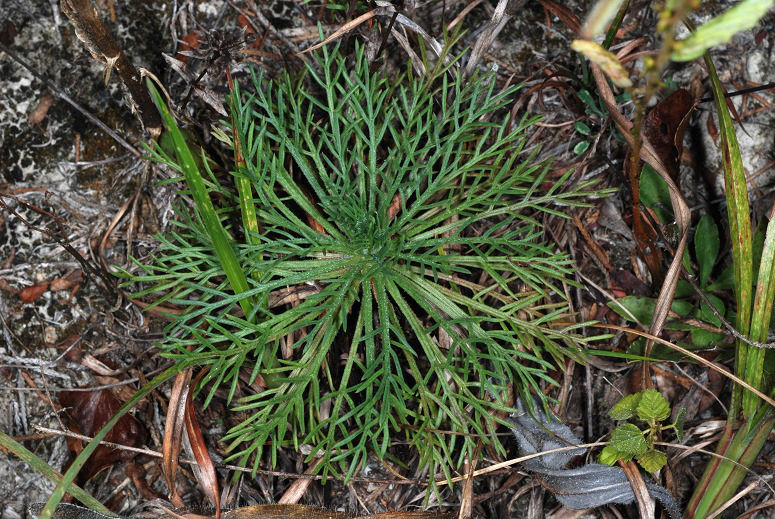Family: Polemoniaceae
Author: (L.) Wherry
Bibliography: Bartonia 18: 56 (1936 publ. 1937)
Year: 1937
Status: accepted
Rank: species
Genus: Ipomopsis
Vegetable: False
Observations: C. & E. U.S.A.
Description
Skyrocket, known scientifically as Ipomopsis rubra, is an enchanting and vibrant plant native to central and eastern regions of the United States. This striking member of the Polemoniaceae family adds a brilliant burst of color to any landscape with its tall, slender spikes of bright red, tubular flowers. These flowers are not only visually captivating but also serve as an enticing nectar source for hummingbirds, making it a favorite among bird enthusiasts and gardeners alike.
First described by Wherry in 1936 and published in Bartonia, the detailed taxonomy and nomenclature of Ipomopsis rubra provide a solid foundation for understanding its botanical significance and ecological role. Both common and scientific names reflect its unique characteristics — while “Skyrocket” evokes its towering growth and explosive floral display, the genus name “Ipomopsis” is derived from Greek, meaning “resembling flax” due to the plant’s superficial similarity to some species in the Linaceae family.
Skyrocket thrives in well-drained soils and open sunny locations, often found gracing prairies, roadsides, and meadows with its fiery blossoms. Its adaptability to various soil types and conditions makes it a resilient choice for naturalizing in gardens or adding a touch of wild beauty to more structured landscapes. Gardeners appreciate this plant not only for its aesthetic appeal but also for its drought tolerance and low maintenance requirements.
This species also plays a critical role in its native ecosystems, supporting pollinator populations and contributing to the biodiversity of the regions it inhabits. The vibrant red flowers are especially attractive to hummingbirds, which act as primary pollinators for the plant. Their visits ensure the cross-pollination necessary for successful seed production, thus maintaining healthy plant populations.
While Ipomopsis rubra is hardy and generally easy to grow, it benefits from periodic deadheading to encourage prolonged blooming. Additionally, introducing it to a garden with plenty of sunlight and ensuring it is not subjected to overly wet soil conditions will support its healthy growth and vibrant display.
Skyrocket’s exuberant blooms, ecological benefits, and minimal care needs make it a remarkable plant for both aesthetic and environmental purposes. Whether cultivated in a native plant garden, a wildlife habitat area, or simply admired in its natural setting, Ipomopsis rubra undoubtedly earns its place as a standout species in the floral world.
Common Names
Swe: praktgilia
Eng: skyrocket, standing-cypress, red standing-cypress, spanish larkspur, texas plume
Fra: ipomopsis rouge
En: Skyrocket, Standing-cypress, Red standing-cypress, Spanish larkspur, Texas plume
Fr: Ipomopsis rouge
Sv: Praktgilia
Synonyms
- Ipomopsis elegans (Michx.)
- Ipomeria coronopifolia ((Willd.) Nutt.)
- Polemonium rubrum (L.)
- Cantua coronopifolia (Willd.)
- Cantua thyrsoidea (Juss.)
- Gilia coronopifolia ((Willd.) Pers.)
- Cantua floridana (Nutt. ex A.Gray)
- Gilia floridana (G.Don)
- Gilia rubra ((L.) A.Heller)
- Gilia rubra var. capillacea (Brand)
- Cantua pinnatifida (Lam.)
- Cantua elegans (Poir.)
- Navarretia rubra ((L.) Kuntze)
- Gilia beyrichiana (Bouché)
- Ipomopsis picta (G.Don)
- Cantua rubra ((L.) Dum.Cours.)
Distribution
- Alabama (native)
- Arkansas (native)
- Delaware (native)
- Florida (native)
- Georgia (native)
- Indiana (native)
- Iowa (native)
- Kansas (native)
- Louisiana (native)
- Maryland (native)
- Masachusettes (native)
- Michigan (native)
- Mississippi (native)
- Missouri (native)
- New Jersey (native)
- North Carolina (native)
- Ohio (native)
- Oklahoma (native)
- South Carolina (native)
- Texas (native)
- Virginia (native)
- Illinois (introduced)
- Kentucky (introduced)
- New York (introduced)
- Ontario (introduced)
- Wisconsin (introduced)
Additional Images
Flower
Taken Jan 13, 2022 by Dante Oroz (cc-by-sa)
Taken Aug 2, 2018 by Cornel Buzea (cc-by-sa)
Taken Sep 24, 2022 by timmi pereira (cc-by-sa)
Taken Nov 21, 2021 by Enciso Emmanuel (cc-by-sa)
Taken Dec 22, 2015 by EOL − Lindsey Smith (cc-by-nc)
Leaf
Taken Aug 30, 2020 by Dorian Petonnet (cc-by-sa)
Taken Jan 12, 2020 by Mary Federico (cc-by-sa)
Taken Mar 23, 2015 by EOL − Jennifer Linde (cc-by-nc)
Taken Feb 9, 2015 by EOL − ktcorson (cc-by-nc)
Taken Dec 1, 2021 by John Pender (cc-by-sa)
Habit
Taken Mar 23, 2015 by EOL − Jennifer Linde (cc-by-nc)
Taken Jun 14, 2013 by EOL − Victor W Fazio III (cc-by-nc)
Taken Mar 23, 2015 by EOL − chuckd (cc-by-nc)
Taken Aug 6, 2014 by EOL − timarcus (cc-by-nc)
Taken Jul 4, 2013 by EOL − Victor W Fazio III (cc-by-nc)
Fruit
Taken Mar 5, 2016 by EOL − brentano (cc-by-nc)

© copyright of the Board of Trustees of the Royal Botanic Gardens, Kew.
Sources
- WFO (No URL)
- IPNI (No URL)
- GBIF (https://www.gbif.org/species/2927974)
- POWO (http://powo.science.kew.org/taxon/urn:lsid:ipni.org:names:129855-2)
- PlantNet (https://identify.plantnet.org/species/the-plant-list/Ipomopsis rubra (L.) Wherry)
Specifications
Growth habit>: Forb/herb
















